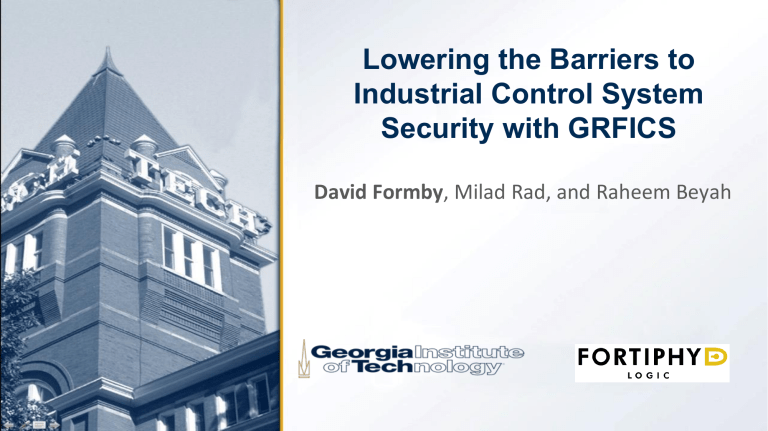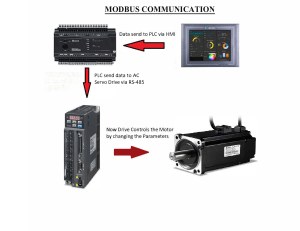
Lowering the Barriers to Industrial Control System Security with GRFICS David Formby, Milad Rad, and Raheem Beyah Introduction • Large cybersecurity skills gap even with good tools • Metasploitable, Kali Linux, previous ASE work • ICS security gap even larger • Expensive equipment and software • Expensive and dangerous to practice physical attacks • No ICS equivalent to Metasploitable • ICS personnel misinformed about security • “Air gap”, not a target, not possible 2 Related Work • Hardware testbeds • Singapore University of Technology • Water treatment facility, water distribution network, and small scale electric power grid network. • Department of Energy - SCADA testbed • Not scalable • Virtual • OpenPLC • Not convincing 3 ICS Background • Insecure by design – No/weak passwords, password policies – No message authentication – Life cycle > 10 years – Difficult to patch • Network defenses critical • Physical “exploit” 4 Programmable Logic Controller (PLC) Background • Essentially industrialized microcontroller – Ruggedized, real-time constraints – Control physical equipment • Programming languages – Ladder logic – graphical, like hardware relays – Structured text – C like language – Instruction list – assembly like language – Function block diagram – Sequential function charts 5 GRFICS Overview 6 GRFICS Overview 7 Physical Process Simulation • Tennessee Eastman Challenge Process – – – – Exothermic chemical reactor simulation Originally for process control engineers, in Fortran Two input feeds, product output and purge valve More efficient at higher pressure • Key measurements – Reactor pressure and level – Cost – i.e. how much is wasted through purge • C++, JSON API over port 55555 8 Simplified Tennessee Eastman Chemical Process 9 Remote IO Layer • Modbus servers on 6 IP address aliases – Report measurements to PLC – Take commands from PLC to control valves • JSON API – Get current values from simulation and update valves 10 Process Simulation • Unity 3D Game Engine – Built-in physics engine for collisions – Popular with active and supportive community • GRFICS – Purchased 3D models of reactor, pipe, valves, warehouse – Get values using JSON API – Overlay current values and summarize in sidepane 11 Visualization of Successful Attacks 12 OpenPLC and libmodbus • OpenPLC – Open source software PLC – Primarily speaks Modbus • Old, common, super simple • Move raw data using registers • Buffer overflow for libmodbus <= v3.0.2 – Mismatch in max number of bytes and number of registers requested – Binary data, no need to encode payload • Standard Debian package 13 Engineering Workstation/HMI 14 Example Attacks – – – – MITM Command injection False data injection Reprogramming PLC • Stuxnet – Loading malicious binary payload • TRITON – Common IT attacks • Password cracking • Buffer overflow 15 Example Defenses – Network segmentation • ISA 95 Reference model – IDS/IPS • Snort rules to detect and/or stop buffer overflow 16 Discussion • Installation – Tedious if from scratch, also have pre-built VMs for download – Good hardware required – 30GB HDD, 8GB RAM, Quad core • Fidelity – Simplified simulation, open source quality not industrial quality – Good enough physics for CS background • Performance – Unity visualization can get slow under attacks 17 Conclusions and Future Work • ICS security skills gap is larger due to higher barriers to entry • GRFICS • Free and open source • Improved realism and engagement over previous work • Future work • Incorporate into graduate level “Cyber physical system security” class • Improve fidelity • “Real” ICS software, larger network • Add more scenarios 18 Questions? Thank you! David Formby djformby@gatech.edu dformby@fortiphyd.com @fortiphyd 19



